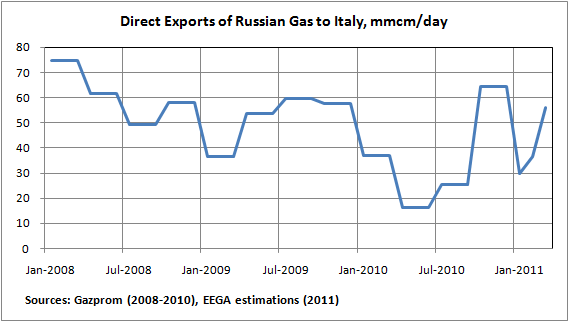|
The
South Stream project of Gazprom is designed to replace TAG (Trans
Austria Gasleitung) pipeline as the route of supply of Russian gas
to Italy.
Italy imports natural
gas via
four pipeline systems and two LNG terminals.
The combination of pipelines and LNG terminals provides secure
supply of gas in case of the outage of one supplier. It was proved
by the
events of January 2009 and the current shutdown of gas flows from
Libya.
Mid- and long-term plans
anticipate the construction of four new import pipeline projects and
up to 13 new LNG regasification terminals.
The combined import capacity of all existing and new projects may
more than double. However, market projections foresee a moderate
demand of imported gas from 70 to 94 bcm/year (EU Energy Trends to
2030 - Updates of 2009 and 2007, respectively).
Gas Import Capacity of
Italy, bcm/year
|
|
2010 |
2025 |
|
Pipelines: |
|
|
|
TransMed
(Algeria-Italy) |
33.5 |
33.5 |
|
Green Stream
(Libya-Italy) |
11.0 |
11.0 |
|
TAG (Trans
Austria Gasleitung) |
37.4 |
37.4 |
|
Transitgas
(Switzerland-Italy) |
19.9 |
19.9 |
|
Subtotal existing pipelines: |
101.8 |
101.8 |
|
TAP (Trans Adriatic Pipeline) |
- |
20.0 |
|
TGI
(Turkey-Greece-Italy) |
- |
11.5 |
|
Galsi
(Algeria-Italy) |
- |
8.0 |
|
South Stream from Slovenia |
- |
24.0 |
|
South Stream from Greece (a) |
- |
10.0 |
|
Subtotal new pipelines: |
- |
73.5 |
|
Total import pipelines: |
101.8 |
175.3 |
|
LNG terminals: |
|
|
|
Panigaglia (La Spezia) |
3.5 |
8.0 |
|
Adriatic LNG Terminal (Porto Levante) |
8.0 |
8.0 |
|
Subtotal existing terminals: |
11.5 |
16.0 |
|
Livorno / Toscana (under construction) |
- |
3.7 |
|
Brindisi (under construction) |
- |
8.0 |
|
Taranto |
- |
8.0 |
|
Porto Empedocie |
- |
8.0 |
|
Priolo Augusta |
- |
8.0 |
|
Senigaglia / Ancona |
- |
5.0 |
|
Gioia Tauro |
- |
12.0 |
|
Ravenna - Atlas LNG |
- |
8.0 |
|
Ravenna - Rosignano |
- |
8.0 |
|
Zaule (Trieste) |
- |
8.0 |
|
Alpi Adriatico (Montefalcone/Trieste Offshore) |
- |
8.0 |
|
Subtotal new terminals: |
- |
84.7 |
|
Total LNG terminals: |
11.5 |
100.7 |
|
TOTAL IMPORT CAPACITY: |
113.3 |
276.0 |
|
Minimum capacity
with South Stream (b) |
|
163.5 |
|
|
|
|
|
Import projections
(c) |
|
70-94 |
(a) Estimation;
(b) No new projects
except South Stream and Livorno and Brindisi terminals;
(c) EU Energy Trends to
2030 - Updates of 2009 and 2007.
Sources: ENI, Edison,
OLT, GIE, RBK.
The table above shows
that the South Stream project can be implemented only as a
replacement for the TAG pipeline,
that delivers Russian gas to Italy via Austria. The
northwestern section of the South Stream pipeline ends at the
Austrian - Italian border near Arnoldstein. TAG delivers gas to the
same place. Even in case of the South Stream pipeline and the two
LNG terminals under construction being the only completed projects,
there is no need for supplies via the TAG pipeline.

According to Gazprom,
direct sales of Russian gas to Italy plunged from 22.3 bcm in 2008
to 13.1 bcm in 2010. The oil-indexed price of Russian gas has become
too high and Gazprom's managers failed to give discounts on time. In
2009, Gazprom has reduced the price and lowered the minimum
take-or-pay volume for ENI, its major partner in the South Stream
project. Apparently, the price discount was not big enough. Average
daily flow of Russian gas in January 2011 was 50-60% below the
average winter level of the pre-crisis years. So, the Libyan flow
shutdown was very timely for Gazprom. It is
worth noting that the average load of TAG pipeline in the period
from March 1 to 24 is reported at 65%.
Observing the declining
sales and a surplus of export capacity, Gazprom still plans to
increase the capacity at the Italian border by another 30-34
bcm/year. Note that Gazprom is unwilling to further reduce the price
of gas. According to
Sergei Komlev of Gazprom-export, the Russian gas giant "would
rather sell less gas at higher price than more gas at a lower
price".
To pay out, South Stream
pipeline needs to be fully loaded. It is absolutely unclear, if the
market conditions would allow Italy to raise imports of expensive
Russian gas to the record level of 30 bcm/year. However, one thing
is clear. If South Stream is built, there will be no Russian gas
coming via the TAG pipeline.
Mikhail Korchemkin
East European Gas
Analysis
Malvern, PA, USA
April 6, 2011
|